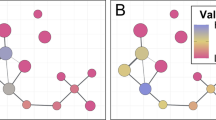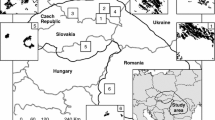Abstract
Connectivity among fragmented areas of habitat has long been acknowledged as important for the viability of biological conservation, especially within highly modified landscapes. Identifying important habitat patches in ecological connectivity is a priority for many conservation strategies, and the application of ‘graph theory’ has been shown to provide useful information on connectivity. Despite the large number of metrics for connectivity derived from graph theory, only a small number have been compared in terms of the importance they assign to nodes in a network. This paper presents a study that aims to define a new set of metrics and compares these with traditional graph-based metrics, used in the prioritization of habitat patches for ecological connectivity. The metrics measured consist of “topological” metrics, “ecological metrics,” and “integrated metrics,” Integrated metrics are a combination of topological and ecological metrics. Eight metrics were applied to the habitat network for the fat-tailed dunnart within Greater Melbourne, Australia. A non-directional network was developed in which nodes were linked to adjacent nodes. These links were then weighted by the effective distance between patches. By applying each of the eight metrics for the study network, nodes were ranked according to their contribution to the overall network connectivity. The structured comparison revealed the similarity and differences in the way the habitat for the fat-tailed dunnart was ranked based on different classes of metrics. Due to the differences in the way the metrics operate, a suitable metric should be chosen that best meets the objectives established by the decision maker.




Similar content being viewed by others
References
Adriaensen F, Chardon JP, De Blust G, Swinnen E, Villalba S, Gulink H, Matthysen E (2003) The application of ‘least-cost’ modelling as a functional landscape model. Landsc Urban Plan 64:233–247
Baranyi G, Saura S, Podani J, Jordán F (2011) Contribution of habitat patches to network connectivity: redundancy and uniqueness of topological indices. Ecol Ind 11(5):1301–1310
Beier P, Majka DR, Spencer WD (2008) Forks in the road: choices in procedures for designing wildland linkages. Conserv Biol 22(4):836–851
Bennett A (2003) Linkages in the landscape: the role of corridors and connectivity in wildlife conservation. The IUCN forest conservation programme; conserving forest ecosystems, vol 1. IUCN, Gland, Switzerland and Cambridge, UK
Bodin O, Norberg J (2007) A network approach for analyzing spatially structured populations in fragmented landscapes. Landscape Ecol 22:31–44
Bodin O, Saura S (2010) Ranking individual habitat patches as connectivity providers: integrating network analysis and patch removal experiments. Ecol Model 221:2393–2405
Cantwell MD, Forman RTT (1993) Landscape graphs: ecological modelling with graph theory to detect configurations common to diverse landscapes. Landscape Ecol 8(4):239–255
Carroll C, McRae BH, Brookes A (2012) Use of linkage mapping and centrality analysis across habitat gradients to conserve connectivity of Gray Wolf population in Western North America. Conserv Biol 26(1):78–87
Collinge SK, Forman RTT (1998) A conceptual model of land conversion processes: predictions and evidence from a microlandscape experiment with grassland insects. Oikos 82(1):66–84
Dale MRT, Fortin MJ (2010) From Graph to Spatial Graph. Annu Rev Ecol Evol Syst 41:21–38
Department of Planning and Community Development (2002) Melbourne 2030: Planning for sustainable growth. Victorian Government Department of Planning and Community Development, Melbourne
Department of Sustainability and Environment (2007) Advisory list of threatened vertebrate fauna in Victoria. Department of Sustainability and Environment, Melbourne
Department of Sustainability and Environment (2009a) Advisory list of threatened invertebrate fauna in Victoria. Department of Sustainability and Environment, Melbourne
Department of Sustainability and Environment (2009b) Delivering Melbourne’s Newest Sustainable Communities. Strategic Impact Assessment Report, Melbourne
Estrada E, Bodin O (2008) Using network centrality measures to manage landscape connectivity. Ecol Appl 18(7):1810–1825
Farina A (2000) Landscape Ecology in Action. Kluwer Academic Publishers, Dordrecht
Ferrari JR, Lookingbill TR, Neel MC (2007) Two measures of landscape-graph connectivity: assessment across gradients in area and configuration. Landscape Ecol 22:1315–1323
Foltête JC, Clauzel C, Vuidel G, Tournant P (2012) Integrating graph-based connectivity metrics into species distribution models. Landscape Ecol 27(4):557–569
Freeman LC (1978) Centrality in social networks conceptual clarification. Social networks 1(3):215–239. doi:10.1016/0378-8733(78)90021-7
Frey H (1991) Energetic significance of torpor and other energyconserving mechanisms in free-living Sminthopsis crassicaudata (Marsupialia: Dasyuridae). Aust J Zool 39:689–708
Galpern P, Manseau M, Fall A (2011) Patch-based graphs of landscape connectivity: a guide to construction, analysis and application for conservation. Biol Conserv 144(1):44–55
García-Feced C, Saura S, Elena-Rosselló R (2011) Improving landscape connectivity in forest districts: a two-stage process for prioritizing agricultural patches for reforestation. Front Ecol Manag 261:154–161
Goodwin BJ (2003) Is landscape connectivity a dependent or independent variable? Landscape Ecol 18:687–699
Gordon A, Simondson D, White M, Moilanen A, Bekessy SA (2009) Integrating conservation planning and landuse planning in urban landscapes. Landscape and Urban Planning 91:183–194
Hahs AK, McDonnell MJ (2006) Selecting independent measures to quantify Melbourne’s urban-rural gradient. Landsc Urban Plan 78:435–448
Hamer AJ, McDonnell MJ (2010) The response of herpetofauna to urbanization: inferring patterns of persistence from wildlife databases. Austral Ecol 35(5):568–580
Hanski I (1994) A practical model of metapopulation dynamics. J Anim Ecol 63:151–162
Hanski I (1997) Predictive and practical metapopulation models: the incidence function approach. In: Tilman D, Kareiva P (eds) Spatial ecology. Princeton University Press, Princeton, USA, pp 21–45
Harary F (1969) Graph Theory. Addison-Wesley Reading Mass, Boston
Henderson MT, Merriam G, wegner J (1985) Patchy environments and species survival: chipmunks in an agricultural mosaic. Biol Conserv 31:95–105
Keitt TH, Urban DL, Milne BT (1997) Detecting critical scales in fragmented landscapes. Conserv Ecol 1(1):4
Kindlmann P, Burel F (2008) Connectivity measures: a review. Landscape Ecol 23:879–890
Laita A, Kotiaho JS, Mönkkönen M (2011) Graph-theoretic connectivity measures: what do they tell us about connectivity? Landscape Ecol 26(7):951–967
Lindenmayer D, Hobbs RJ (eds) (2007) Managing and designing landscapes for conservation: moving from perspectives to principles (Conservation Science and Practice). Blackwell Publishing, Hoboken
Magle SB, Theobald DM, Crooks KR (2009) A comparison of metrics predicting landscape connectivity for a highly interactive species along an urban gradient in Colorado. USA. Landsc Ecol 24(2):267–280
Mastisziw TC, Murray AT (2009) Connectivity change in habitat networks. Landscape Ecol 24:89–100
McIntyre S, Hobbs R (1999) A framework for conceptualizing human effects on landscapes and its relevance to management and research models. Conserv Biol 13(6):1282–1292
McRae BH, Kavanagh DM (2011) Linkage Mapper Connectivity Analysis Software. The Nature Conservancy. http://www.circuitscape.org/linkagemappe
Menkhorst PW, Bennett A (eds) (1995) Mammals of Victoria: distribution, ecology and conservation. Oxford University Press, Melbourne
Menkhorst PW, Kenight F (2001) A Field Guide to the Mammals of Australia. Oxford University Press, Australia
Morton S (1976) Ecological and Physiological Studies of Sminthopsis Crassicaudata. Melbourne University, Melbourne
Noss RF, Dobson AP, Baldwin R, Beier P, Davis CR, Dellasala DA, Francis J, Locke H, Nowak K, Lopez R, Reining C, Trombulak SC, Tabor G (2012) Bolder thinking for conservation. Conserv Biol 26(1):1–4
O’Brien D, Manseau M, Fall A, Fortin MJ (2006) Testing the importance of spatial configuration of winter habitat for woodland caribou: an application of graph theory. Biol Conserv 130(1):70–83
Opsahl T, Agneessens F, Skvoretz J (2010) Node centrality in weighted networks: generalizing degree and shortest paths. Social Networks 32(3):245–251
Pascual-Hortal L, Saura S (2006) Comparison and development of new graph-based landscape connectivity indices: towards the priorization of habitat patches and corridors for conservation. Landscape Ecol 21:959–967
Rayfield B, Fortin M-J, Fall A (2011) Connectivity for conservation: a framework to classify network measures. Ecology 92(4):847–858
Read DG (1984) Movements and home ranges of three sympatric dasyurids, Sminthopsis crassicaudata, Planigale gilesi and P. tenuirostris (Marsupialia), in semiarid western New South Wales. Australian. Wildlife Research 11(2):223–234
Rothley KD, Rae C (2005) Working backwards to move forwards: graph-based connectivity metrics for reserve network selection. Environ Model Assess 10:107–113
Saura S, Pascual-Hortal L (2007) A new habitat availability index to integrate connectivity in landscape conservation planning: comparison with existing indices and application of case study. Landsc Urban Plann 83:91–103
Saura S, Estreguil C, Mouton C, Rodríguez-Freire M (2011) Network analysis to assess landscape connectivity trends: application to European forests (1990-2000). Ecol Ind 11:407–416
The Economist Intelligence Unit (2011) A Summary of the Liveability Ranking and Overview. www.eiu.com. www.eiu.com. Accessed 3 Nov 2011
Urban D, Keitt T (2001) Landscape connectivity: a graph-theoretic perspective. Ecology 82(5):1205–1218
Urban DL, Minor ES, Treml EA, Schick RS (2009) Graph model of habitat mosaics. Ecol Lett 12:260–273
Vasas V, Magura T, Jordan F, Tothmeresz B (2009) Graph theory in action: evaluating planned highway tracks based on connectivity measures. Landscape Ecol 24:581–586
Victorian Environmental Assessment Council (2010) Remnant Native Vegetation Investigation; Discussion Paper
Wheater PC (1999) Urban Habitats. Routledge, London
Acknowledgments
The Department of Sustainability and Environment of the Victorian Government supplied the input data for this study. Special thanks to Dr. Matt White who prepared the input habitat maps for this study. Thanks go to Dr. Peter Menkhorst who provided consultation on the spatial ecology of the fat-tailed dunnart and filled in the questionnaires. Special thanks to Dr. Brad McRae and Dr. Bronwyn Rayfield for their valuable guidance on the use of Linkage Mapper and least-cost modeling. Sincere thanks go to Mr. Hossein Pourali and Mr. Stephen Page for their technical advice on ArcGIS. Dr. Tore Opsahl gave valuable guidance on the use of tnet package of software R. Ascelin Gordon was supported by the Australian Research Council Centre of Excellence for Environmental Decisions. The Iranian Ministry of Science, Research and Technology sponsored this research.
Author information
Authors and Affiliations
Corresponding author
Additional information
Dr. David Fraser retired now from SMGS RMIT University.
Rights and permissions
About this article
Cite this article
Poodat, F., Arrowsmith, C., Fraser, D. et al. Prioritizing Urban Habitats for Connectivity Conservation: Integrating Centrality and Ecological Metrics. Environmental Management 56, 664–674 (2015). https://doi.org/10.1007/s00267-015-0520-2
Received:
Accepted:
Published:
Issue Date:
DOI: https://doi.org/10.1007/s00267-015-0520-2




